Posted by · Leave a Comment
Our host, Tracy Toth, shares her recipe for making homemade butter.
Posted by · Leave a Comment
Our host, Tracy Toth, shares her recipe for making homemade butter.
Posted by · 2 Comments
Let’s do a little math. We ordered a quarter-pound packet of Waltham butternut seeds, knowing that would more than cover us for planting in the spring (we had some seed left from last year) and ended up planting only half that amount. The packet was $8.95.
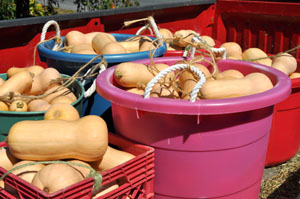
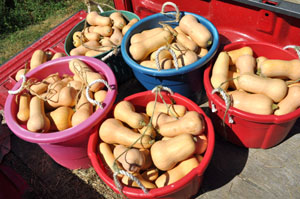 We are in the midst of harvesting the butternuts now. This load is the first picking and represents about 500 pounds. Altogether? We’ll get about 1500 pounds of butternut squash out of the less-than-half packet of seed that was planted.
We are in the midst of harvesting the butternuts now. This load is the first picking and represents about 500 pounds. Altogether? We’ll get about 1500 pounds of butternut squash out of the less-than-half packet of seed that was planted.
The Waltham variety is an extremely popular variety — not only with us but with the pollinators. (Remember the blog entry about the bees buzzing in the blossoms?) Its flavor is delicious, it keeps well (we’ll store ours through the winter in our basement, which stays cool and dry), and the plants are consistent and reliable.
So, it’s inexpensive + proven + tasty + reliable + bountiful = A winner!
Posted by · Leave a Comment
End of summer and everybody’s sad…just look at the sad sunflowers!

 The children have been back at school for two weeks now and we’ve started to harvest butternut squash which can only mean one thing: summer’s officially over.
The children have been back at school for two weeks now and we’ve started to harvest butternut squash which can only mean one thing: summer’s officially over.
It’s funny, really, that you can’t wait for the summer season to begin and when the “end” rolls around, it’s almost welcome.
I’m tired! And just look at the sunflowers; I think they’re tired, too, of holding up their large, seeded heads in the unbearable heat and blinding light of the sun. I look at them thinking they give up at about this same time each year. 
I noticed the sun setting at 6:30 last night. Two months ago, I’d be weeding at this time, thinking “Thank goodness I have two more hours to work.” Now? I’m happy to be thinking ahead to apple butter, early morning frosts, and Indian corn. That is, until the seed catalogs come at the end of winter and it’s time to choose those sunflower seeds again.
Posted by · Leave a Comment
It’s been four weeks for the cherry wine and it’s time to rack, or siphon off, the liquid from the must (this is the fruit “by-product” which has settled to the bottom of the carboy).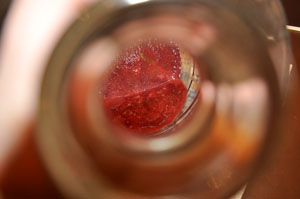
I lifted the five-gallon carboy to the kitchen counter the night before so the must would have a chance to rest undisturbed, overnight, and settle once again. {You need the full vessel higher than the empty vessel to which you will transfer the wine).
Next, be sure your equipment is clean and sterile for the transfer.
Once the siphon is going, it will likely empty the carboy in one continuous, steady draw.  Make sure the intake is not resting in the must. Remember, the object is to capture only “clean” wine in this rack—leave behind as many particles as possible.
Make sure the intake is not resting in the must. Remember, the object is to capture only “clean” wine in this rack—leave behind as many particles as possible.
You will probably see a little bubbling activity in this transfer. There will still be yeast present and the agitation will activate it.
Once the transfer is complete, get your fermentation lock on. One fruit gnat carries enough bacteria to ruin the batch (amazing, right?). Find a place for your carboy to call home for the next few months where it’ll be out of the way and the temperature will be somewhat regulated.
Bottling for this batch of cherry wine will occur close to the holidays!
Posted by · Leave a Comment
I think I got lucky today. You see, the weather was cooler and windier than it has been all summer—so I decided it’d be a pleasant afternoon to pick the rest of the Concord grapes.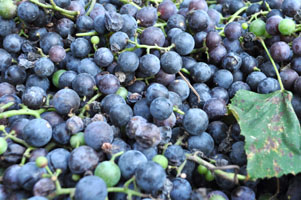
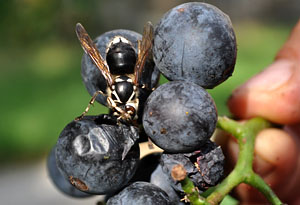 About two minutes into the task, I saw my first bald-faced hornet. And then another. And then another. In and around the grapes and vines with their heads tucked into the fruit and tails a’waggin’.
About two minutes into the task, I saw my first bald-faced hornet. And then another. And then another. In and around the grapes and vines with their heads tucked into the fruit and tails a’waggin’.
Only later did I learn it’s best to approach the nest (which I have yet to find) in cooler temps and that this species can, and will, sting repeatedly because the stinger does not come out with the attack. Hmmm.
Looks like I’ll be scouting for that nest tomorrow. I just hope the weather stays cool.
Posted by · 2 Comments
I’m not the biggest fan of fennel. However, it makes for a beautiful display in the herb garden. Its early stages appear feathery like a young dill plant. Later in the summer, the thickened stalks become tinged in a copper color and it shoots upwards in excess of five feet. The seed heads are numerous and bursting with fennel seeds right now—the perfect time to chop them off to stop them from spreading!!
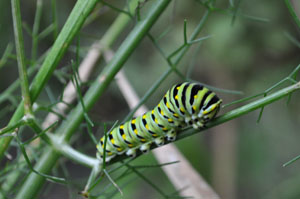 So there I was whacking away at the stalks, when I spotted this beautiful caterpillar balanced on a lower stem. I paused, momentarily, because the stripes were so unique. When I spotted the second one
So there I was whacking away at the stalks, when I spotted this beautiful caterpillar balanced on a lower stem. I paused, momentarily, because the stripes were so unique. When I spotted the second one 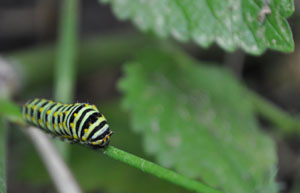 on the stalks, I put down my clippers. What was the connection between these caterpillars and this fennel plant?
on the stalks, I put down my clippers. What was the connection between these caterpillars and this fennel plant?
After some online research, I learned adult butterflies feed on nectar plants while caterpillars feed on host plants. Those host plants are singled out by individual species for their ability to feed and nurture a caterpillar. Some butterflies are so picky, there is only one host plant upon which they lay their eggs and feed (such as the Monarch’s relationship with milkweed plants).
 The caterpillars on the fennel plant are Eastern Black Swallowtails and feed on fennel, parsley, carrot, and dill. Wow. What a delicate balance?! I took this picture of a Black Swallowtail in my flower garden two months ago—not realizing how beneficial it would be to have a fennel plant a mere 20 feet away. I think I can learn to love fennel again—because I sure love these butterflies.
The caterpillars on the fennel plant are Eastern Black Swallowtails and feed on fennel, parsley, carrot, and dill. Wow. What a delicate balance?! I took this picture of a Black Swallowtail in my flower garden two months ago—not realizing how beneficial it would be to have a fennel plant a mere 20 feet away. I think I can learn to love fennel again—because I sure love these butterflies.
Posted by · Leave a Comment
Our host, Tracy Toth, continues our tour with Leon Moyer of Moyer’s Chicks Inc., a hatchery in Quakertown, Pa.
If you missed it, click here to view Part One of this webisode.
Posted by · Leave a Comment
 A trip to a hatchery! I’ve wondered about these magical places ever since our after-hours pick up of our first box of day-old chicks from the local post office (and I bet you thought chicks came from hens).
A trip to a hatchery! I’ve wondered about these magical places ever since our after-hours pick up of our first box of day-old chicks from the local post office (and I bet you thought chicks came from hens).
Leon Moyer, co-owner (with his brother, Ivan) of Moyer’s Hatchery in Quakertown, Pa., gave us the grand tour! We witnessed each stage: the uncrating of the eggs arriving from southern egg farms, the placing of the eggs onto trays ready for the incubator, the carefully-timed rotation of the eggs (mimicking mama’s instincts), the transfer of the eggs to “baskets” readied for hatching chicks, to the boxing and shipping of the new babies!
The Moyer family is one that has always believed in a commitment to community (which was the biggest reason Leon’s father wanted to begin his agricultural-based business in the late 40s). Leon, his brother Ivan, and their families have carried on their father’s tradition.
The Moyers have reached out internationally to contribute to communities around the globe, spending years helping people to develop poultry operations in Bolivia, Haiti, and Uzbekistan, to name a few. I was very happy to have had the pleasure of a hatchery tour…and very proud to have met such a generous person. Thank you, Leon!
Be sure to visit www.moyerschicks.com
Posted by · 1 Comment
Our host, Tracy Toth, takes us on a tour of Moyer’s Chicks Inc., a hatchery in Quakertown, Pa. In this webisode we learn that at the hatchery, the egg definitely comes first.
The tour is a two-part webisode. Click here to watch Part Two.
Posted by · 1 Comment
 We bade a fond farewell to our sweet corn a week ago.
We bade a fond farewell to our sweet corn a week ago.
Nothing, and I mean nothing, beats the taste of a freshly picked ear of sweet corn.  My husband always plants the old standby “Silver Queen.” It’s been a popular variety with farmers for decades and has a maturity of 92 days. This year, we also planted “Bodacious” which has a 75-day maturity and “Delectable” with an 84-day maturity. The different days to maturity as well as staggered plantings, allow for a sweet corn harvest over several summer weeks if you’re a savvy planter!
My husband always plants the old standby “Silver Queen.” It’s been a popular variety with farmers for decades and has a maturity of 92 days. This year, we also planted “Bodacious” which has a 75-day maturity and “Delectable” with an 84-day maturity. The different days to maturity as well as staggered plantings, allow for a sweet corn harvest over several summer weeks if you’re a savvy planter!
I’ve frozen corn in the past by cutting it from the cob, blanching it, and securing in freezer bags. I’ve even canned it—which is fairly time-consuming because of the processing time in the pressure canner. The best way to enjoy it, though, is right out of your garden, right out of the pot, and  right off the cob!
right off the cob!
Parting is such sweet sorrow…